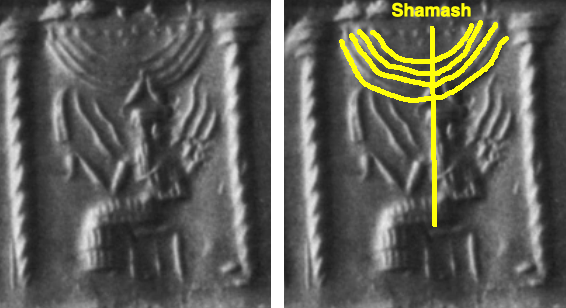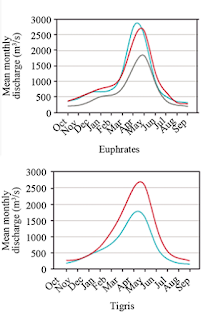This is one of the most interesting seals I have ever seen. It was found in the scribal quarters of Nippur, and was documented in the excavation report published by the Oriental Institute of the University of Chicago.
I am not sure exactly what the dating of this seal is, but the scribal quarter has layers from Akkadian, Gutian and the Third Dynasty of Ur periods...So the late 3rd mil BC...
So why is this seal so interesting? Let me explain: The seal depicts the sun god Utu/Shamash, identifiable by the wavy sun/heat rays emanating from his shoulders.
I talked about this in my post "Utu or Enki" about the above images found in an incredible book called "Seal cylinders of Wester Asia".
This same symbolism was found not only in Mesopotamia in the late 3rd mil BC...This is a great example of the use of related animal calendar markers. Bactrian two side seal. Sun god with sun rays emanating from his shoulders (like Shamash/Utu), with snakes, symbols of sun's heat and winged lion, Nergal, symbol of hottest part of the year...
I talked about this in my post "Summer and winter BMAC seals"...
Utu/Shamash is sitting on a throne, holding a cerated knife, another one of his identifying symbols...That tells us that this is old Utu/Shamash, the summer sun...
Sun God Utu/Shamash with sun (heat) rays emanating from his shoulders, standing in in an empty canal, in Leo (between the lions), the hottest, driest time of the year in Mesopotamia, and the time when canals were repaired, holding reed cutting knife...I talked about this in my post "Canals"
I talked about young and old Utu/Shamash here
It is Young Utu/Shamash, Spring Sun, who climbs up the mountains to release Enki/Ea, (god of) fresh water, from (his) it's icy prison. It is he who fills the rivers and canals...And it is Old Utu/Shamash, Summer Sun, who empties them...I talked about this in my post "Shamash young and old"...
On our Nipur seal, Shamash is flanked by two bull-men, holding (???)...Whatever they are holding, is telling us that we are looking at the sun in Taurus, Apr/May, beginning of summer, ruled by the old Utu/Shamash...
Similar to this:
The sun god stands "between two bulls", which means "in Taurus" (Apr/May). Out of the bulls grows grain, which means beginning of grain harvest in Apr/May...From my post "Bull carrying grannary"...
Sooooo....What's so special about this???
Remember my post "The tree of light/life" about the solar symbolism of Menorah?
In it I talked about the fact that the central candle of the Hanukah (Solstice) Menorah is called Shamash, and that this candle has to be lit first, and then used to light all the other candles...
Now have a look at the central part of the Shamash cylinder seal from Nippur. Are you seeing what I am seeing, or am I just seeing things...again? Is this a symbolic depiction of the Menorah emanating from Shamash himself?
I think this could finally settle the debate about why the central Menorah candle is called Shamash, and why Menorahs are lit during winter solstice, the time when "people have to make sure the sun's fire does't die"...Which BTW is the point of Yule logs...
"The ancient fire-festival of the winter solstice...has survived...in the custom of the Yule log...[once]...widespread in Europe, it seems to have flourished especially in England, France, and among the South Slavs"...From "The Golden Bough"...I talked about Yule log tradition from around Europe in my posts "Badnjak", "First footer", "La buche de Noel", "Yule log in English tradition"
Now, as I explained in my post about Menorah, Menorah was not just the solar symbol, but also the tree of life symbol...Remember this post, "Bactrian bronze age menorah" about the tree of life depiction on this super cool Bactrian bronze stamp, dated to 2400BC-1600BC...
All the images of the rampant goats flanking the tree of life can be explained through animal calendar markers: Ibex goats mating season, which starts in Oct/Nov, overlaps with the rain season in all these areas, and it is the rain that makes life possible in these arid lands...
The ibex goat mating season peaks around the winter solstice/Hanukah...When the Menorahs are lit up using central Shamash candle...Until now I could not see the direct link between the solar and tree of life meaning of Menorah...But now I can...
Remember, every spring, the young Utu/Shamash, the spring sun, climbs up the mountains to release the fresh water (Enki/Ea) from its icy prison (melt the snow)
Which is why the poem "Enki and Ninhursanga" states that "When Utu [the sun god] steps up into Heaven (Holy mountain), fresh waters shall run out of the ground for you"...I talked about this in my post "When Utu steps up into heaven"...
The snowmelt peaks at the beginning of summer, Apr/May, in Taurus.
Which is when Tigris and Euphrates flood reaches its peak.
Which is why Utu/Shamash was depicted as a golden bull (Sun in Taurus) with flowing lapis lazuli beard (flowing water)...
And it is this flood (caused by the snowmelt, caused by the sun, Utu/Shamash) that was the (main) source of life in Mesopotamia...The tree of life literally grew out of Shamash...
Makes more sense now? 🙂
I want to thank my friend @dalaygiz for this great observation: 3-waves on each side, with the solar-head in the centre 🤔
Oh and BTW, in Mesopotamia, summer lasted seven hot months...Which is why local dragon, symbol of summer, had seven snake (symbol of sun's heat) heads...So number seven (seven lights) here becomes kind of obvious??? I talked about this in my post "Seven headed dragon"...
That's it. To read more about ancient animal and plant calendar markers, start here…then check the rest of the blog posts related to animal calendar markers I still didn't add to this page, and finally check my twitter threads I still didn't convert to blog post...I am 9 months behind now...





















Nice link. Shamash ~ s(h)abbat(h) 7th day-night, 7th lamp. In Hawaiian a torch flame is lama, in Malay, apa.
ReplyDeleteso, the thing is, all these seven-month things would make much more sense if it was purely solar calendar and one of the months was short intercalary one.
ReplyDelete...but they seems to didnt? and instead point at solar activity in lunar months?? or, like, in a very loose defenition of month.
and then its more likely that "seven" part of it is not originally-solar but external, stellar one? pleiades / solar system bodies or whatever.